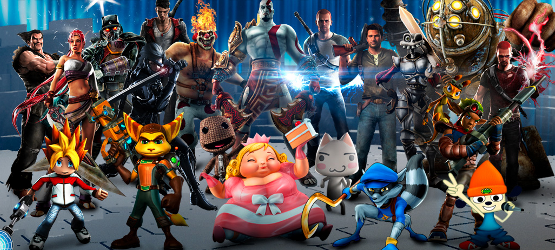It has been a long time coming, longer than it even should feel thanks to the endless rumors and leaks that occurred ahead of the PlayStation All-Stars official announcement. It’s a game that the PlayStation community has long been dreaming about, ever since Nintendo released their first franchise mash-up brawler, Super Smash Bros. With the same goals in mind—putting each respective brand’s biggest and brightest stars on its roster into one game—they’re bound to draw many comparisons. PlayStation All-Stars: Battle Royale is no longer just a dream or a rumor, it’s a real game, ready to make its way into the hands of PlayStation fans everywhere as of today, and it’s time to see if it has the chops to roll with Smash Bros‘ punches.
The first thing to take notice of, is the 20-character roster filled with PlayStation icons from generations past and present. These aren’t just characters found in PlayStation exclusives, the roster even reaches out to third-party games that just so happen to be synonymous with PlayStation consoles—and some not so synonymous, yet still welcome additions such as BioShock‘s Big Daddy. Big Daddy and his Little Sister join the likes of Nathan Drake from Uncharted, Raiden from Metal Gear Rising, (emo) Dante from DmC Devil May Cry, and old-timers like PaRappa the Rapper, or foreign imports such as the Japanese news reporting cat, Toro.
Each character’s special moves and more powerful and more effective super moves perfectly match what you might see from them in their own games. SuperBot has done an outstanding job of taking each persona, and perfectly extending it into All-Stars‘ movesets. It’s almost as if each was ripped as is from their respective games and franchises, and placed directly into the roster.
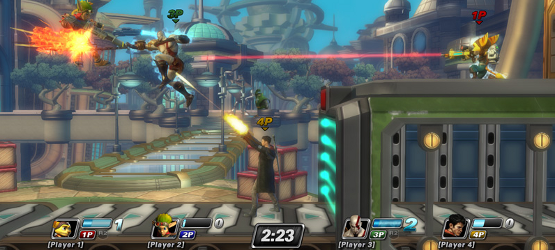
These PlayStation mainstays do battle on an immensely PlayStation canvas, complete with stages, weapons, and hazards plucked right out of each franchise’s most memorable moments. And they’re all mashed up, yet they come together so well to create something unique. You’ve seen it in the screenshots: a God of War style arena with a giant Hades wrecking havoc on the action, until the cutesy Patapon hand Hades a pata-pata-pata-beatdown. There are so many other well-done mashups like this, taking Metal Gear Ray and tossing him in LocoRoco land, or having Dr. Nefarious invade the just invaded streets of San Francisco, where the Chimera are pushing the human race toward extinction. The best part about that level for me isn’t even the mashup or the fighting itself, it’s the touch of completeness and polish that’s added by the first-person shooter introduction to that very level—almost as if Nathan Hale was the cameraman, heading into battle, yet stumbling upon a fight of a different kind.
As with each character’s persona, the style and feel of every arena absolutely screams: PlayStation. Just how well the development teams have manged to capture the essence of every character, every game, and every franchise is easily All-Stars‘ biggest accomplishment.
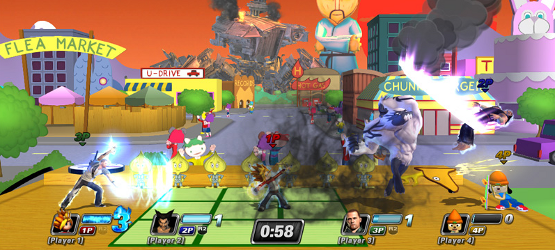
The gameplay itself doesn’t quite shine so brightly, though. It’s not bad, or broken, but it’s definitely designed with ease of access in mind—meaning, PlayStation All-Stars: Battle Royale may leave hardcore fighting fans a less than satiated by the depth or complexity of the combat. This is both a good and bad thing, because while it may lack the depth needed for serious competitors, it does allow for more casual fun for all ages and skill levels. Someone can hold their own in PSASBR who may not last more than a few seconds at an EVO tournament. Even button mashers have a shot, here. Although, the more thinking you add to your strategy, the more successful you are bound to be.
The X button jumps, and the rest of the face buttons are mapped out to various attacks. Combining each attack button with a direction changes up the attack. Blocking, evading, taunting and, of course, attacks, all builds the ever-vital AP meter. Throwing an enemy causes them to spill their AP as orbs, which you can collect for your own. AP is the super meter’s currency, and the more you deposit, the better checks you can write. There are three levels of increasingly powerful super moves, all tailored perfectly to fit each character’s persona.
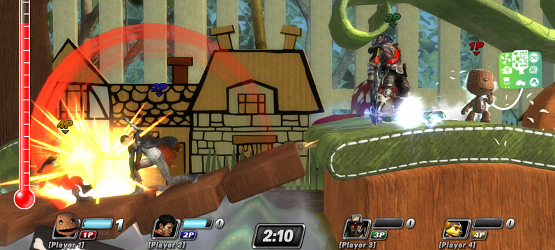
The combat lives and dies by these super moves, literally. It’s the only way you can kill or be killed. That’s not to say that the rest of the combat doesn’t matter, as that’s where the fun and build up to these super moves comes into effect. Landing a super move attack on an opponent will cause them to burst into an explosion of squares, triangles, exes, and circles. It also gives you two points added to your total score. Anytime your character is killed, you lose one point. The final tally of kills and deaths will determine the winner. It’s a very simple formula for success—kill or be killed—and adds to that same accessibility and fun factor, while detracting from any serious depth. Let’s face it, it’s frustrating knowing you’ve kicked ass the entire match skills-wise, but you missed your super move, and all three opponents just so happened to connect with theirs. Your score sucks, and you’re going to have a bad time. You’re also a sore loser, then. Ha! But at least you’ll have fun trying.
Any fighting game is designed for two players or more, but if you happen to be all by your lonesome, there is still a wealth of content to keep you going. Arcade mode, a standard for any fighter, lets you play through the majority of the roster in different teams, waves, and stipulations until you get to the last boss, Polygon Man. If you’re not familiar with Polygon Man, here’s a refresher: He’s an old advertisement/mascot for the original PlayStation that was gone faster than he appeared. As the story goes, Ken Kutaragi was said to hate Polygon Man, and ordered his removal from association with the brand. Well, he’s pissed and he’s back as a giant head to take revenge. He, like many of the other towering beasts is really one of the background stage hazards. He both summons possessed versions of fighters to present themselves as obstacles and morphs into other stage hazards seen throughout the game; such as the Satan Chimera, or Dollface’s Iron Maiden from Twisted Metal. After you clear the screen of enemies, his massive spiked purple head comes crashing down on you, giving you a chance to attack. Polygon Man isn’t opposing, but it’s a great throwback to the longest of long-time PlayStation fans, while removing any tie to a franchise from the last boss. Smart move, in my opinion.
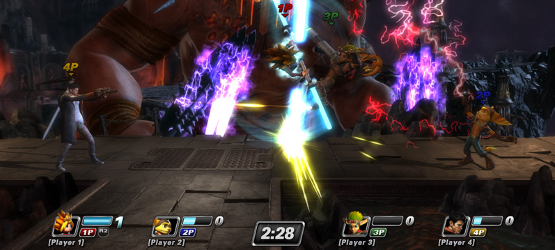
Outside of the Arcade mode, there are challenges, both general and character specific. These not only act as a thorough tutorial, teaching the ins and outs of the game’s combat intricacies, but also adds to each character’s rank and provides some added challenge, fun, and variety.
Rank is increased through any mode, and as your rank increases, a huge portion of extras are waiting to be unlocked. Extras include alternate costumes, taunts, intros, outros and more. It also opens up the possibility to customize your profile card that’s displayed preceding any matches. You can trick it out with icons, backgrounds, and you can bring a little deformed looking side-character called a “Minion” to cheer you on during battle. These extras don’t make or break the game by any means, but they do serve as good reason to play extensively with each character, whether you like them or not. It also gives the most dedicated players bragging rights, as their characters will be dressed cooler, and have better music and the like.
After some practice, hopping online is just as simple as getting into a local match. Matchmaking is a breeze, and inviting friends is easy. Whether you’re fighting in a ranked or unranked match, the servers are hiccup and lag free. There may not be a lot of modes to choose from, but the real action is in the midst of four-player free-for-alls, anyway. Depending on how good you are at the game, you can take a gander at your season statistics globally, or compared to your friends list. If you suck, you may want to look the other way.
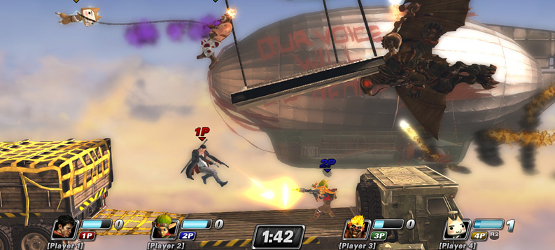
Buying PlayStation All-Stars on the PS3, whether digitally or at retail, also gets you a digital copy of PSASBR on the PS Vita via Sony’s Cross-Buy promotion. It instantly adds significant value if you happen to own both of Sony’s systems. And again, with this being a game designed for PlayStation fans, this is all the more likely of a scenario. We’ll delve deeper into the PlayStation Vita version offers in a separate review, but in short, the two versions are virtually indistinguishable, offering the same modes, characters, and smooth fighting mayhem.
With or without nabbing the PlayStation Vita version of the game, too, PlayStation All-Stars will keep you fighting for a long while after purchase. Even when the single player content dries up, there will always be competition waiting for you online. When the credits roll, the first thing you’ll read is “A very special thank you to all of the PlayStation fans”. And that’s exactly what PlayStation All-Stars is—a tribute to the PlayStation fans that have supported the brand over the years, and whom have been eagerly awaiting a game like this since the advent of Smash Bros. SuperBot has delivered a game that embodies everything these iconic PlayStation franchises and characters offer, and it will surely make PlayStation fans proud.
Read our review of PlayStation All-Stars: Battle Royale on the PlayStation Vita>>
-
PlayStation characters are well-represented via style, moves
-
A strong mix of old and new, first- and third-party characters.
-
Combat is extremely fun.
-
Plenty of single-player content.
-
The answer to the prayers of PlayStation fans everywhere.
-
Combat does lack depth for hardcore fighting fans.
-
Could have used a few more old-school characters.
-
Snake? Snaaaaaaaaake? And where's Cloud? Crash Bandicoot?
